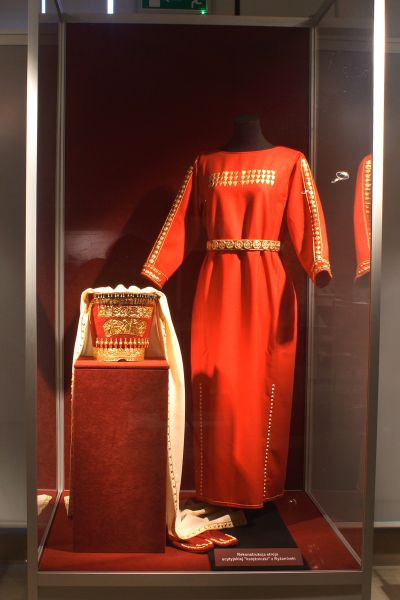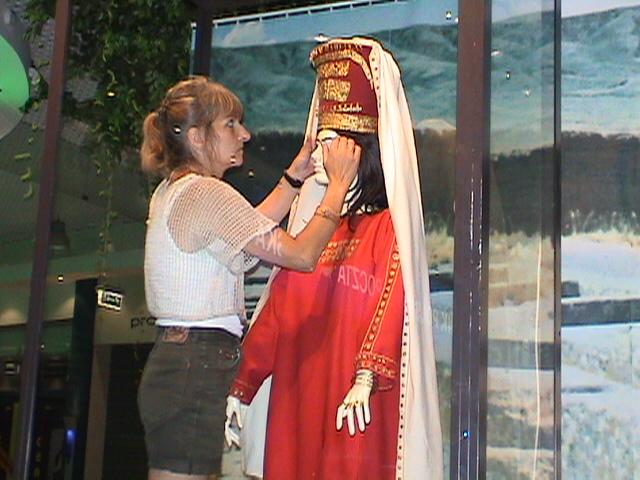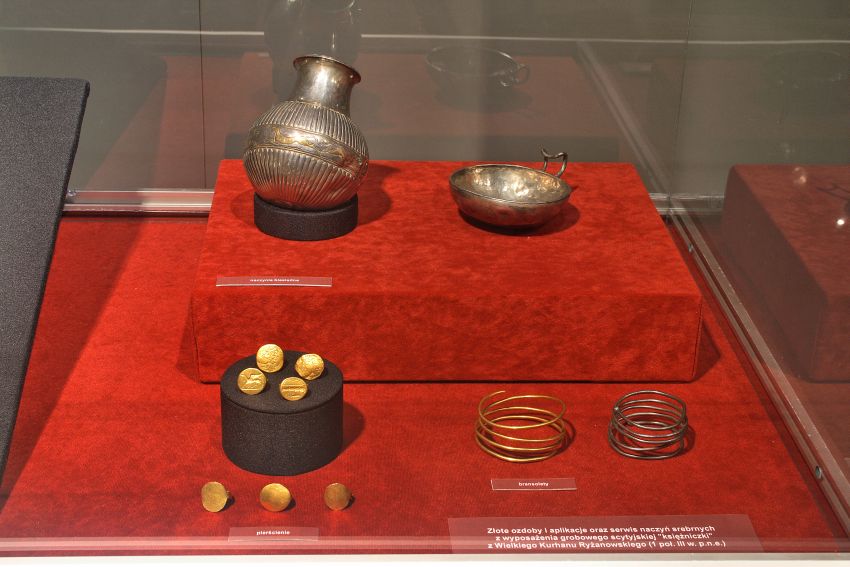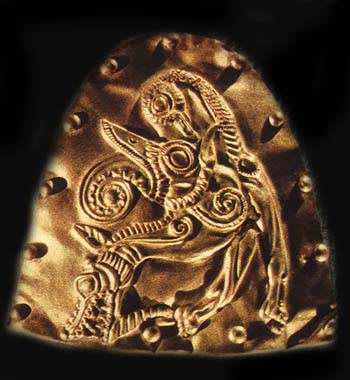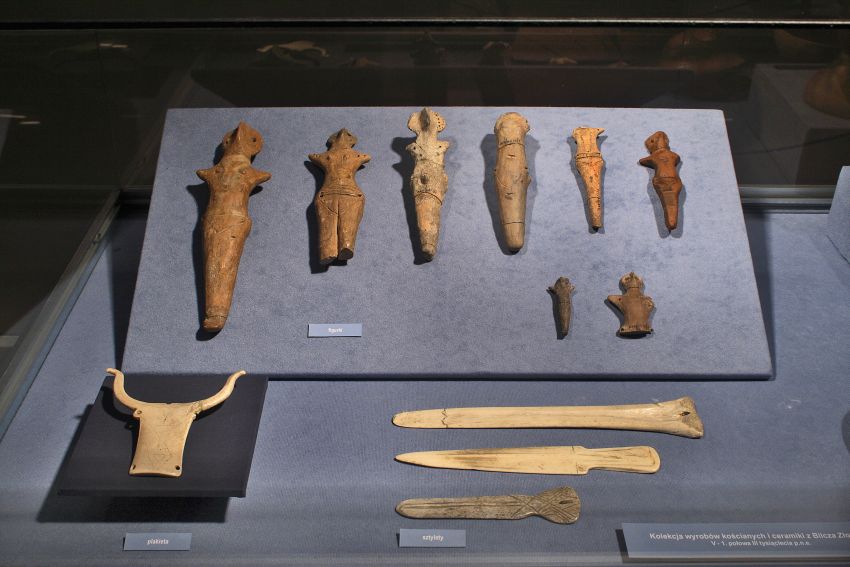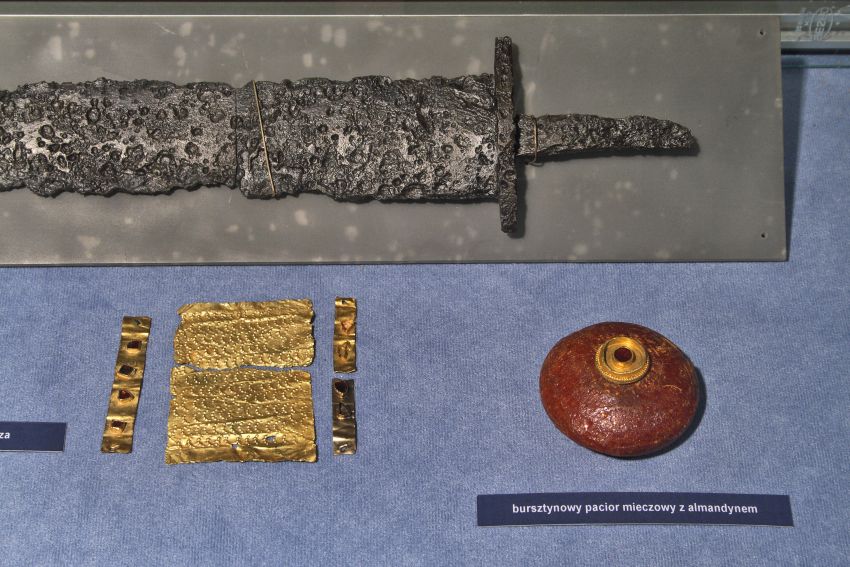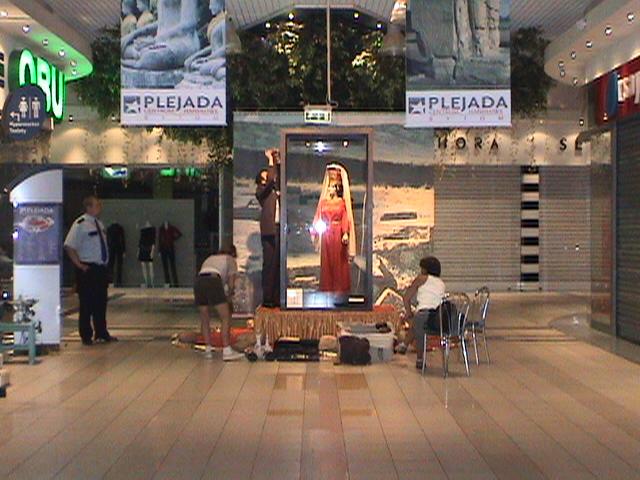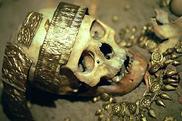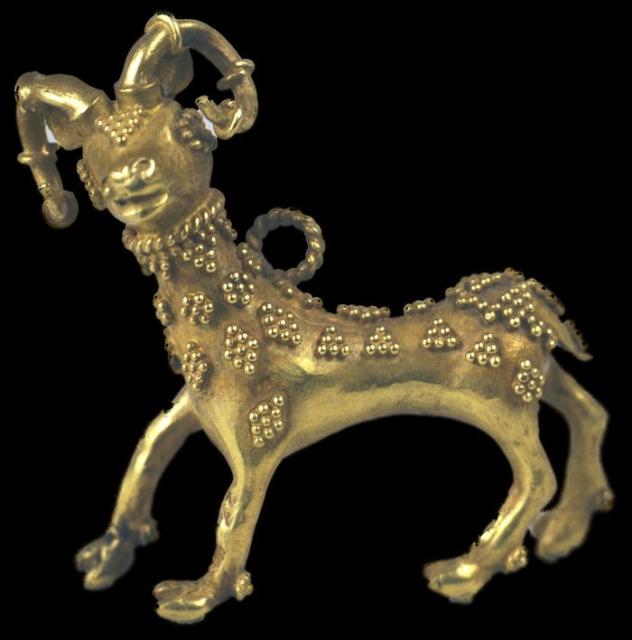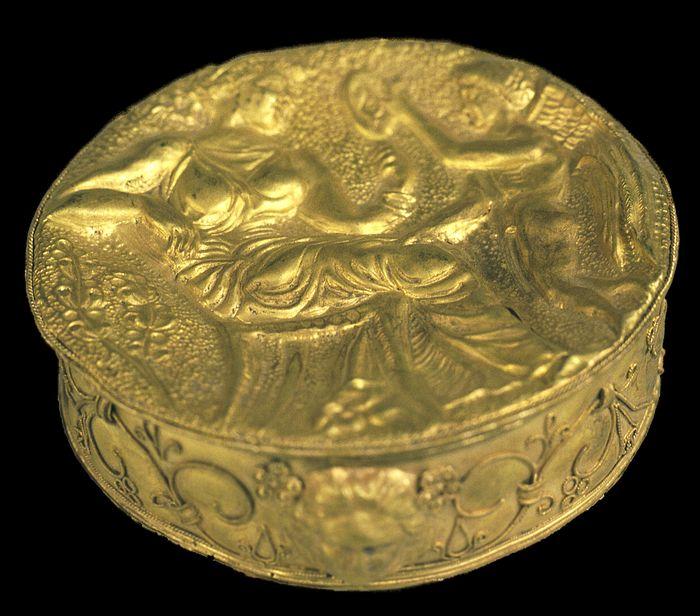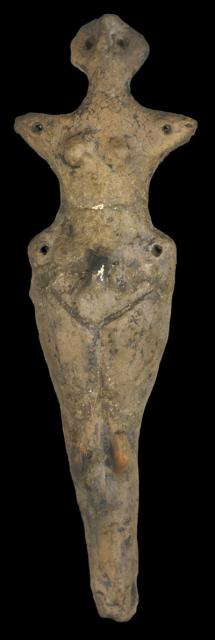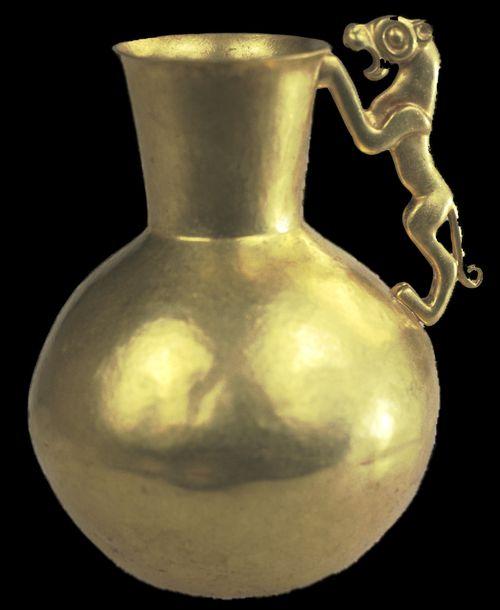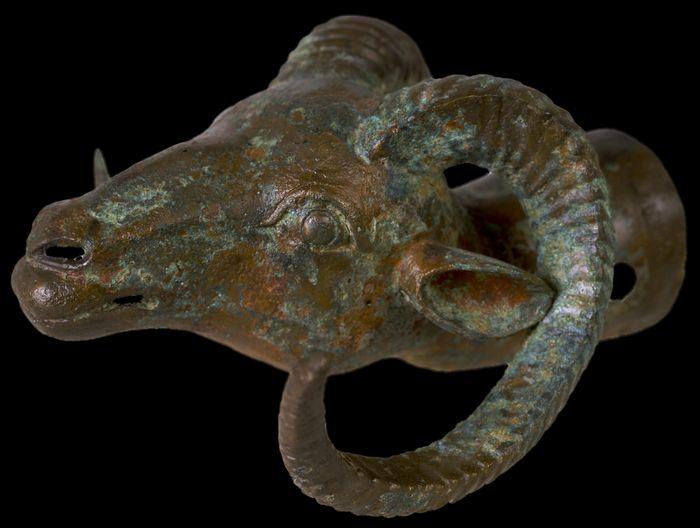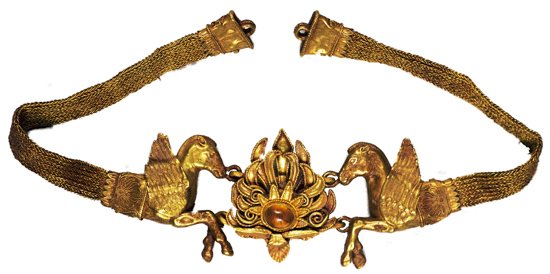© by Czesław Białczyński
© translated by Katarzyna Goliszek
How the Sun helped Scolotians enter the White Land
The costume of the queen or of the princess (kagan-prince’s wife) of Scolotians (Scyths) of Ryżanówka – the Archaeological Museum in Krakow. The shape of the coronation cap draws attention – the same shako (Polish czako) was worn by robbers near Kraków from the Mountains of Harowie-Harnasie – Karniosie, in other words Karopanowie – and among them was Janosik.
The article quoted by us below is very superficial because it was supposed to be popular. It was released long ago, in 2005, but it contains accurate (though too one-sided and narrow) justification for the rapid development of the region of Siberia – precisely by the example of the Valley of Tuva. One can agree with the proposition that the climate change of a global character in 850 BC caused the demographic development of the region of previously dry and semi-arid areas. However, we need to bring this text to constructive criticism, which at the same time will show how our Four-Volume Book and the Slavs’ Historic Tales (Baje) are being made.
Preparing the Princess of Ryżanówka for an exibition in Bytom. Scolotian farmers looked so, the ploughmen recorded by Herodotus. The tomb and its treasures are dated to 400 BC.
Simple theses are made and simple sensational solutions are given in the article, so simple that they make the impression of being far-fetched and assigned to a premise adopted in advance.
If the authors of the article had not been looking so narrowly at the world – in terms of an exclusively adopted hypothesis and had not limited themselves to the point of view through the perspective of their specialisation in the „Scythian” subject, they – moving a step farther in their thinking – would have also had to state that it was all right that at the same time Celts from the coastal areas of the Netherlands emigrated to the east – where there was still a place, and that also Wędowie (Wenetowie – Veneti ) from the plains emigrated to the east and south – where the marvellous climatic conditions started to be.
Few treasures from the tomb of the Princess
It was likely to have happened. As usual some of the Celts (Kiełtowie) stayed in place in these geographic areas where water did not reach – closer to the Alps (The White Mountains of Kaukowie, i.e. The Białoboże Mountains). Also the Veneti (Wędowie) settled in the higher regions where water did not reach – in The Łyskogóry (The Łysko Mountains) also called The Świętogóry (The Holy Mountains), i.e. around Łysica, near The Giant Mountains (Góry Karkonosza – The Mountains of Karkonosz – Krakonios – and the Mountains of Harowie (Horpątowie, or Kharpątowie) – in Harski (Hercynski) Forest. Perhaps this is the cause of the famous event described by Herodotus, who says that one year (and it happened around 800 BC) large quantities of Snakes (Węże) came onto the Land of the Nurowie tribe and the Nurowie had to run away from their land, and they moved to the country of the Budinoi (Budynowie). After a while, however, they returned to their homeland.
Another royal head cover of the Scyths – Sokolo-Veneti, i.e. of the Solo-Weni
Who were the Węże (Snakes)? Perhaps Herodotus had no direct messages but from other sources, collected from various merchants and explorers who heard local stories and not understanding them wholly they misinterpreted something. Herodotus himself might have misinterpreted something as well and improbable, fantastic tale about snakes came out of it. In our opinion, this is an interpretation but not really unfounded – primarily not snakes (węże) or Wężowie were meant here, but these were Wędowie – in other words the people of Weneade <pronounced: venedae> known from records of Romaiōi (from Greek and Roman records), also written as Venetoi (Unedoi) in slightly later documents, the name of which we would pronounce Wenedawi <venedavi>.
In our view and according to our historical tales, these were mixed tribes of peoples leaving flat plains near the Baltic Sea – Wędowie (Wenedowie) and Dawowie (Dawianie, Drakowie, Odrakowie) known later as Dakhowie of the Danube, Dhakowie of Asia Minor (the Dahowie who also lived in the east close to Mazogątowie, known from records under the name of Massagetae) as well as Drakowie and Odrysowie (i.e. recorded by the Romans later as Trakowie – Thracians).
How familiar, well known from the discoveries in Deszczno or Wolin worship figures – here from Bilcza Złota (Trypillian Culture)
There is another possible interpretation of the message about the invasion of Węże. According to it, the given name had the meaning close to the known word by the Author serpen – wąż. Then it would have been said in the ancient message (travel news) about the Serbs of Wenedowie (Veneti) who having left the White Serbia (so Wielkopolska) invaded the Nurusi – i.e. Nurowie and Budinoi (Budynowie) living in the east and south of them.
Our hypothesis does not contradict the scientific hypothesis from the article quoted below.
In our view, it could have been then that the Scolotians and the Veneti intermingled (and perhaps Istowie-Jątowie of more Illyrian roots) and the new Irano-Slavic, and perhaps Irano-Balto-Slavic people arose, the people who created the Kingdom of Sis ranging from Kamchatka to the Rhine and Lake Constance, where the settlement of the Veneti – people known as genetic Slavs – is also said to have existed.
Moreover, there is archaeological confirmation as well as information in the chronicles that also some tribes of Celts – whom we call Kumorowie (as they lived near Mor-Rus people, in Mor-Rawa) and who were recorded as Kimmerowie (Cimmerians) by the Romaiōi (Greeks). They were defeated by the Scolotians of the Dnieper (Scythian-Slavic and returned to Moravia, where they lived next to Slavic (Sokolo-Wendowie) Morusowie, and at one point rose to great power that attacked both Rome and North Caroduna (near Kraków, Haria). Except that the migration of the Celts (Kiełtowie) to Haria took place more peacefully and Rome as a richer and an attractive target to loot was systematically invaded and plundered by them.
We do not intend to replace the science, let alone teach it – the interpretation of the new discoveries of science presented above is to serve us only for the purpose of the Tale (Baja) – and help us restore legendary (mythical) history of Slavs. This happens so, and we use it this way.
The Hun Weapon (of Guniowie tribe that in the best period was led by Hatiłła-Chytiłła, also known to the West as Attila, but we know Istia names by analogy, for example Jagiełło, Dowgiłła and others.
The thought process which I have presented here illustrates both where the bases for reconstructing the Tale come from and demonstrates one of the thought-proof sequences locating and fixing some facts on the World historical and geographical map.
None of the stories of the Four-Volume Book, even the slightest one, is just made up as each of them has at least – if not much stronger – a basis in the chronicles, archaeology, linguistics, etymology, ethnography, anthropology, genetics, and in hundreds of other topics.
The princess showed up in Bytom
According to our Slavic Tale (Baja) (Slavic Mythology) came into existance Sis Kingdom – The Kingdom of Scolotians-Istowie-Slavs, called the Great Skolotia which bordered through Siberia Tuva and areas around Lake Orol (Aral), Lake Baikal and Balkhash with Mążgołowie-Mongols (Hairless men but, on the other hand, the Great – Golems) and Kutaje (the Chinese) – in other words Kitaje /pronounced: kitaye/, i.e. the experts of Taje /pronounced: taye/ (Mysteries) – records, and through the Caucasus and Welburz (The Mountains of Black Kaukowie, Czarnogłowskie and Elbrus) and by Oroja /pronounced: oroya/ (Ararat) and the Sea of Kosz (Koszpijskie, Caspian) with Persians and Medowie /pronounced: medovye/, and Syria and Egypt (Melkomedir).
The development of this and other interpretations of the discoveries of recent times can be found in the History (Dzieje) reproduced in the Book of Rue (Księga Ruty).
Soon on the pages of our BLOG of the Old Slavic Temple of Light of the World we will make available Taja 19 of the Book of Rue and fragments talking about clashes of Scolotians with Kumorowie on the Dnieper as well as about Kumorowie in Haria. And now the already mentioned article and another one which proves the genetic relationships of Scyths/Scythians and today’s Slavs.
The Skull of the Princess of Ryżanówka, tiara and necklace
The Sun helped the Scyths to conquer Eastern Europe
Andrew Hołdys
2005-01-28, last modified 2005-01-29 0:00
An article the authors of which decided to explain one of the bigger mysteries of the early history of Europe was published in the „Journal of Archaeological Science”. It says about sudden appearance of Scyths in the east of the continent. How to explain the invasion of these Asian people?
MAPKA: Russia, Ukraine, Tuva – the home of the Scyths, Kazakhstan, Mongolia, China
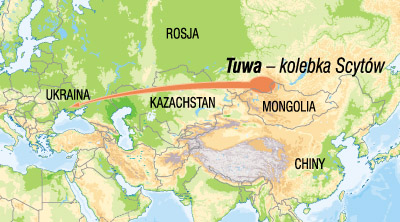 |
This time archaeologists asked biologists and geologists for help. A group of researchers from Russia, Germany and the Netherlands, led by Bas van Geel from the University of Amsterdam, explored the mystery of ancient burial mounds in southern Siberia for three years. The explanation of the scholars was: The march of the Scyths was caused by a rapid climate change.

The model of a „temple” – associated with the cult of the rectangular building with a gable roof, set on supported platform pillars and decorated with motifs of iconic and symbolic significance. Trypillian Culture, clay.
Siberian Valley of the Kings
The first Scyths arrived in Europe around the year 800 BC, around the beginning of the Iron Age. For many centuries they were a major political force in the eastern part of the continent. They were fond of the steppes north of the Black Sea. Their main locations were on the Don and the Dnieper. From there, they would set off to the west and south of Europe, they also made their way to the Middle East. Neither the powerful Persian king Darius I, nor the greatest leader of antiquity Alexander the Great was able to defeat them.
Treasures of the tombs of Ukraine, Kazakhstan and Siberia. Pendant in the shape of a Pamirian horned sheep . The fourth century BC, gold decorated with granulation
That all has been known for a long time including, among others, information from „father of history” Herodotus and thanks to the discovery of many mounds in southern Russia and Ukraine. In these mounds Scythian warriors were buried thousands of years ago. Most of the tombs were destroyed and looted, fortunately thieves did not get to all of them.
In them, archaeologists usually find hundreds of ornaments made of gold as well as everyday items, including distinctive weapons and horse harness .
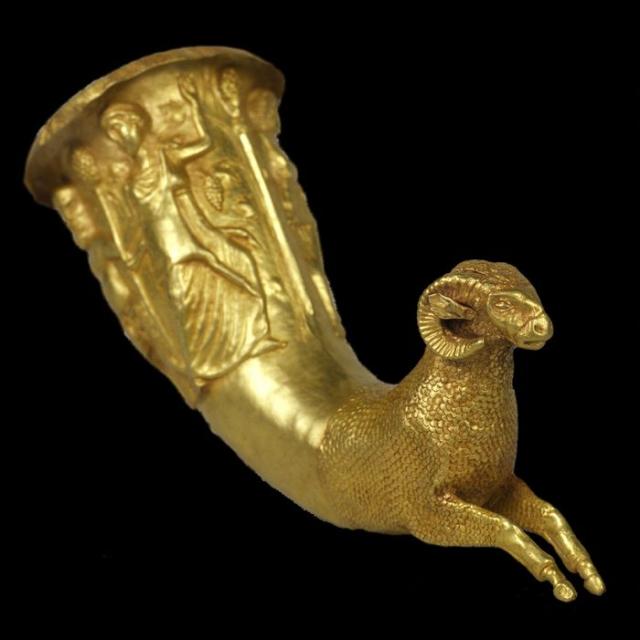
Treasures of the tombs of Ukraine, Kazakhstan and Siberia Rhyton decorated with the front part of a ram. The fourth century BC. Gold.
Why, after all, did the Scyths arrive in Europe, what were the events that made the Black Sea steppes suddenly pound with hooves of horses carrying on their backs nomadic raiders from the East nearly three thousand years ago? To find an answer to this question, the scientists went to the place where everything began – to Tuva, the autonomous republic included in the Russian Federation neighbouring with Mongolia.
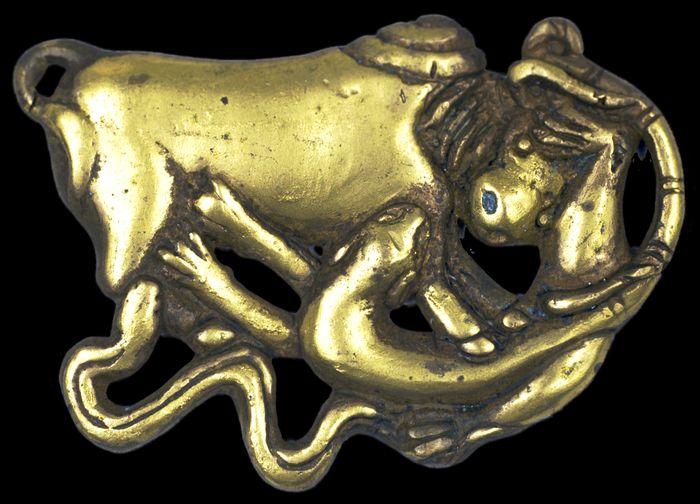
A belt clasp. The 2nd-1st century BC, gilded bronze
In the summer of 2001, Konstantin Czugunow from the St. Petersburg Hermitage and Hermann Parzinger from the German Archaeological Institute unearthed a Scythian tomb in one of the Tuva’s basins, which was called Arzhan-2. Inside of it, they found skeletons of men and women and about 5 thousand objects made of gold around them. Among them, there was a breastplate weighing 1,5 kilograms, ornamental pins 30cm long with pictures of animals carved on their surface, daggers encrusted with precious stones. Altogether there was more than 20 kilograms of gold.
Pyxis (a Greek box for valuables), the 4th-3rd century BC. gold
There are a lot of similar burials in this area. They belong to the rulers of these lands so some say about the Scythian Valley of Kings. Earlier, these tombs had been as rich as Arzhan-2, but thieves started to plunder most of them. The oldest date back to the 9th century BC, when the nomads from southern Siberia were preparing to migrate to the west. Before they moved in the direction of Europe, they had already gained a high level of material culture. The content of the tombs of Tuva is the evidence of that – emphasises professor Parzinger.
Treasures of the tombs of Ukraine, Kazakhstan and Siberia. A figure of a woman, Trypillian culture, 3 650 – 3 500 BC, clay modeled by hand
Tuva – the land of plenty
The advancement of civilisation was instant and surprising – according to the study conducted by van Geel and colleagues. Earlier, the inhabitants of this land had lived a modest life in the dry steppe. Mountain valleys of Tuva – a country half the size of Poland – had been omitted by them because it had been just an inhospitable semi-desert. The researchers found that by analysing pollen that was preserved in the layers of the river and lake sediments from that period.
The turning point came around the year 850 BC. Surprisingly, as if by magic everything changed. The air temperature dropped and heavy rains began to fall making the steppe overgrown with lush grass. This can also be read from pollen. Arid Tuva turned into a land of plenty within a few decades. Groups of nomads, one after another, moved to this Asian paradise. Had it not been for the climatic change, the Scyths would have never become the military and political power. They would have never moved to the west in search of new territories. The weather helped them. But for the weather, the steppe that extends from Siberia as far as Ukraine, could feed horses of the Scythian army and herds of cattle. The way to Europe was open for the nomads.
Treasures of the tombs of Ukraine, Kazakhstan and Siberia Oinochoe (pitcher) with a handle in the shape of a panther. The 2nd-1st century BC. gold
The sun gives less heat
Why did the weather change so suddenly? – It was the effect of the sun activity which weakened significantly during that time – says van Geel. How do we know it? There is no direct evidence, the scholar says but he states that it is easy to find it out analysing the content of C14 coal in the archaeological material collected from Tuva’s mounds. This radioactive isotope is formed in the Earth’s atmosphere under the influence of cosmic rays – the stronger it is, the more atoms of C14 carbon are formed. It happens so when, among others, the sun reduces its activity. At this time weakens the solar wind which blows off the part of cosmic particles rushing towards the Erath.
– The measurements show that some three thousand years ago the level of C14 carbon in the atmosphere began to grow rapidly. This is because the sun started to heat less – says the Dutch researcher. – The shortage of solar heat quickly led to a drop in temperatures and made the climate become wet. Soon after that began the march of the Scyths.
Treasures of the tombs of Ukraine, Kazakhstan and Siberia. Ram’s head. Completion of the car thill (?). the 5th-3rd century BC. bronze
Deluge in Biskupin
Scientists point out that the sudden change of the climate that began in the 9th century BC had a global reach. It was for the Scyths that the change turned out to be beneficial because the dry steppes of Central Asia desperately needed rain.
In Central and Western Europe, however, it was different. Here, heavy rains led to floods and rise of water levels in lakes. Van Geel who does research os the history of climate in his homeland said that at that time farmers from the area of present-day Netherlands were forced to abandon homes and flee to the east.
A similar fate befell the inhabitants of our Biskupin which was built about 750 BC. The damp climate made grandchildren and great-grandchildren of the founders of the settlement leave it after several years because it was flooded by the lake on which it was built. Nature can be unfair. When refugees from Biskupin or the Netherlands were wandering around Europe in search of a piece of dry space to build their home, Scyths – thanks to favourable nature – were just beginning to build their powerful state on the Dnieper and the Don.
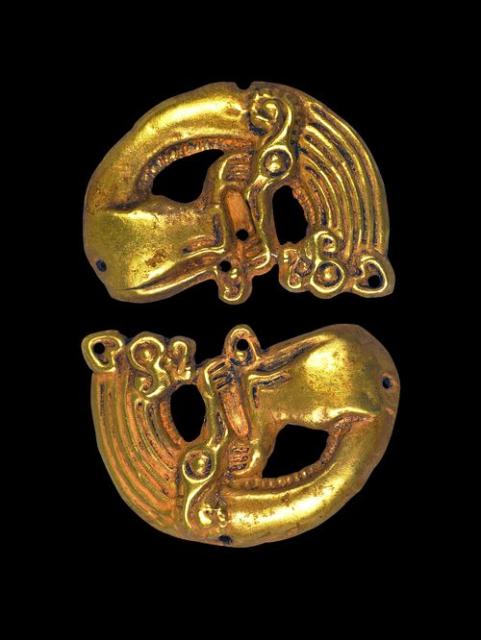
Treasures of the tombs of Ukraine, Kazakhstan and Siberia. Two Scythian applied ornaments in the shape of panthers. The 4th century BC. Gold
And some other Scolotian and Romaiōi treasures from Ukraine (Skraina)
Taken out of the black market
Treasures of Ukraine from the collection of Platar. After years of commotion they were shown at the exhibition in the Warsaw National Museum. However, controversies and an atmosphere of a scandal were not omitted.
Deer. A badge used for ornaments of Scythian garments. The 4th century BC, gold
Necklaces decorated with granulation, filigree and precious stones, bracelets, earrings, rings and decorated everyday objects are only part of objects presenting achievements of ancient and medieval goldsmiths, collected at the exhibition of the Ancient Treasures of Ukraine. Ukraine for the world.
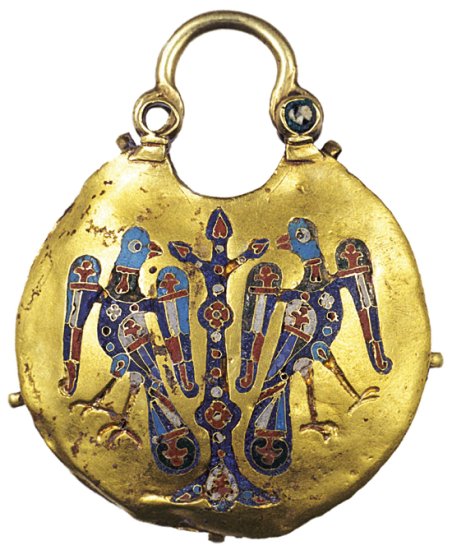
’Kołtka’ (temporal pendant), Kievan Rus the 12th-13th centuries, gold vitreous enamel
Goldsmithing throughout centuries
In the National Museum in Warsaw there can be seen masterpieces of Trypillian culture that are older than the Aegean culture. There can be seen almost 500 items from the time embracing 18 centuries – from the 6th century BC to the 12th century AD. They are artistic masterpieces of Trypillian culture that is older than the Aegean culture, the items coming from the times of nomadic tribes of Cimmerians, Scyths and Sarmatians who liked glamour, as well as Greeks, Romans, Byzantium and Kievan Rus.
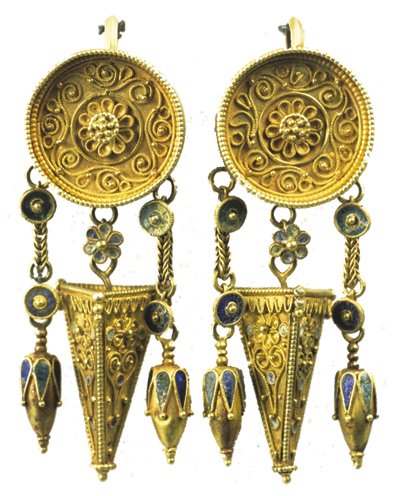
Both the beautifully ornamented Trypillian vessels and everyday objects, as well as gold jewels: goldsmith masterpieces in the motifs of animals typical of steppe peoples, classical and misterly Greek jewels, Byzantine decorations and devotional articles, and jewellery of Rus, e.g. pendants ornamented with temporal bows delight the viewer.
It is the rich collection of gold jewellery made by Greek goldsmiths for collonists and Scythian aristocrats that makes the greatest impression. Professor Witold Dobrowolski, curator of the ancient art collection in the National Museum and chief of the exhibition
points out that many of the bracelets, necklaces, pendants, earrings and rings are the works of the highest artistic attempts. They are as gorgeous as objects collected in national museums and on the basis of them we can trace the evolution of forms and methods of ornamentation.
Conflict of interests
The exhibition is the first presentation of the collection of the late Sergei Platar and Sergei Taruta, two Ukrainian industrialists and patrons, outside of their own country. Platar and Taruta collected several thousand exhibits over 10 years. They often bought them on the black archaeological market, which neither they nor Professor Witold Dobrowolski conceal. Explaining the creation of the collection using patriotic incentives, but not in a totally honest way upsets, after all, archaeologists and art historians.

Greek Fibula in the shape of a bee, the 4th century BC.
The market was shocked by controversies: rescue works of art at any price, although purchasing them secretly gives rise to development of illegal trading, or allow for their despersion in hidden collections of collectioners from all over the world. Pieces of art can be bought even at usual bazaars, after all. For example, in Sevastopol or in the Kiev Collectioner’s Club as though Ukrainian militia know about it, they do not react to it. Historians are also indignant at collectors’ focusing only on the market value of their collections. The most beautiful and the most valuable objects dug out of ancient graves go to the hands of the richest, the remaining ones become which makes it impossible to enrich knowledge about ancient cultures.
Scientists’ dispute
Some museum curators refuse to present Platar and Taruta’s collections as accepting them would mean acceptance of the ways of getting masterpieces. In professor Jan Chochorowski’s view who is the head of the Institute of Archaeology of the Jagiellonian University, organising such an exhibition is ennoblement of criminal activity and complicity in the crime. Others, for example professor Michał Gawlikowski, chairman of the Scientific Board of the Centre of Meditteraneam Archaeology of the University of Warsaw, do not regard it as anything wrong emphasising that, as a matter of fact, the collectors bought the items from robbers and dealers, but that at least, thanks to that, they were not taken outside of the boundaries of Ukraine.
Professor Dobrowolski also agreed with these arguments … and with the beauty of the collection. The National Museum had not had a possibility to show the achievements of ancient goldsmiths for several decades. The older generations were able to see the Scythian gold from Hermitage, 30 years ago in 1976 as well as the gold of ancient Italy in 1962. Despite the controversies one should not overlook the Ancient Treasures of Ukraine for we never know when there will be the next occasion to learn about the works of goldsmiths of the old centuries.
♦
Slavs and Scyths/Scythians means one and the same people according to geneticists
The home of Pre-Slavs were the territories spreading from the Baltic Sea to the Carpathian Mountains and from the Oder as far as the central Desna and the upper Donet. Linguists: T. Lehr-Spławiński, M. Rudnicki, T. Milewski, S. Rospond and others say this. Generally, geneticists confirm this because people who live in the mentioned area are quite homogeneous genetically with dominant genetic markers, i.e. haplotypes which are Slavic. There are not, however, any haplotypes which are related to Italian, Illirian or Germanic tribes. Well, Kossina, Jordanes and Kokowski can be put aside on the shelf for sure. Their hypotheses claimed the other day as certainty do not work now.
No foreign linguistic and genetic influences indicate Slavs’ autonomy in the territory between the Oder and the Dnieper. Genetics also excludes the theories of so called eastern origin of the Slavs, which means arriving of a greater quantity which would change into a new quality, from the east into genes of the natives of the foreign – not Slavic – genetic material. This DNA does not exist.
Well, how much likely it is that both Veneti/ Venedi and Scyths were Slavs.
Until present the Scyths have been described on the basis of the own linguistic-etymological chunks (archaeological discoveries) and records known from Greek, Persian and other interpretations – as Iranian people. It is just genetics that discovers that the Scyths were not Iranians, but that they were different people living in a huge area from the Vistula and the Dnieper as far as Baikal and Balkhash and the Aral Sea, Styr-Daria and India (the Indus and even the Ganges at a certain period of time).
The recently studied ancient Scythian DNA turns out to be very close to the Slavic one both regarding the haplotype of Y-STR (markers contained in the masculine chromosome Y) as well as autosomally (i.e. in other chromosomes). This signifies a close biological kinship. On genetic maps of Europe the ancient Scythian autosomal DNA is exactly in the same place as the DNA of today Polish and Russian people. At present the old tenet that the Scyths living at the black Sea were an Iranian tribe is undermined because it has been discovered that Iranian Ossetians – regarded as the descendants of the Scyths till that time – have nothing in common with the Scyths (a different DNA). Now there is no evidence telling that the Scyths spoke an Iranian dialect. Moreover, there are no traces of any presence of Iranian dialects among the people living in these areas in the historical times. It is uncmmon for the language to have disappeared so suddenly. Yet, another scenario is very probable. This scenario joins the Scyths and the Slavs through which a new, concise language was developed, the language taking from the previous two in such proportions in which those peoples contributed something new in terms of culture and civilisation into the common heritage.
Herodotus wrote that Royal Scyths as well as other ”Scythian” tribes living in the north (Neurowie, Budynowie – Budinoi, Gelonowie, etc.) had simmilar customs and spoke the same language.
Until now, science has not been able to find the answer to the question what happened to the huge masses of the Scyths – because there can not have been just a few of them as they ruled over a vast area with neighbours of such demographic powers as the Greeks, the Persians, the Chinese and others. According to the presently modern concepts it was the Huns that drove the Scyths away from the eastern steppe. We do not believe it because what could have stopped them suddenly from going to the Don or the Dnieper or to the Vistula? A sudden change of their idea of ruling the world or other views to getting easy loots?
What happened then with the Scyths of the Dniepir and Caucasus or with the Scyths of the Vistula if the Huns suddenlt felt they would not kill them?
In our opinion, nothing happened with them. The people of the steppe were absorbed by the Scyths-Slavs ”of the forest” because the Scyths Ploughmen and other Scyths mentioned in the records (Royal Nomadic Budinoi, Gelonowie, Neurowie) were simply ”Scyths-Slavs”. The reason for which we can not distinguish the Scyths from the Slavs today is that they did not differ with anything special from one another. They spoke a similar language, they looked similar, they had a similar DNA, similar customs, religion, etc.
Herodotus writes that when the Persian army entered the country of the Scyths, they sent wagons with their belongings, their wives, etc. to the north, to the neighbouring tribes. Probably the same thing happened when the Scyths/Sarmatians were attacked by the Huns from the east and the Romans as well as the Greeks from the west and south. Unable to sustain the territory, they retreated deep into the possessed lands fleeing from the attacked limes, in other words more to the north and east. Of course, not all of them gave in, some of them stayed and gave in to the new rulers – Thracians-Drakowie, Dawanowie, Odrysi, Dakowie (Dahowie) did so. New tribes entered the abandoned territories to some places where there were free fields, for example Germanic tribes wandering through the Scolotians-Slavs’ territories of the Vistula and the Oder, and then along the Danube where wars with Rome were waged.
I think it was the subsequent internal fights for supremacy between the various tribes of the Scyths/Slavs and the war with Rome and epidemics, or adverse effects of climatic changes, it could also have been a collapse of manufacture and trade with Rome that caused the economic crisis and the general poverty in the territories between the Baltic Sea and the Carpathian Mountains.
All things considered, on the basis of the data that provides us with genetics, linguistics, archaeology and historiography, it is the most likely that the first home, the pre source of the Slavs were the territories between the Oder and the Dnieper as well as between the Carpathians and the Baltic. This is a big enough area to house such a huge tribe. Personally, I do not believe in a demographic explosion or any other fibs – nobody has given any evidence for this. Neither do I believe in migrations and a total swap of great agricultural peoples. It is always some groups that migrate, not all peoples.
Tagged with: princess, archaeological discoveries, Ryżanówka, Scyths, Slavs

